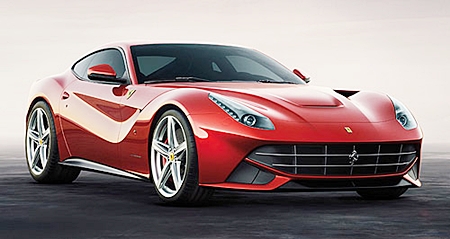Ferrari’s fastest and most powerful road car ever was revealed at the Geneva motor show in the beginning of March.
The Ferrari engine is a 6.3 liter naturally aspirated V12 that develops 730 hp (544 kW) that develops its peak power at 8500 rpm and can cover zero to 100 km/h in 3.1 seconds.
 Ferrari F12 Berlinetta.
Ferrari F12 Berlinetta.
Ferrari sources also claim the F12 Berlinetta covers zero to 200 km/h in 8.5 seconds on its way to a maximum speed of “more than 340 km/h”.
It has also turned in a lap time of 1 min 23 sec at Ferrari’s Fiorano test circuit – faster than any other Ferrari road car before it, including the previous benchmark-setting 599 GTO which took a second longer to complete the lap.
The engine is based on the same 6,262cc direct-injection 65 degree V12 found in the somewhat ugly four-seater Ferrari FF, the F12 Berlinetta has more bhp than the FF (485 kW) or the previous 599 GTO (500 kW), with maximum torque of 690 Nm at 6000 rpm, 80 percent of which is available from 2500 rpm and which provides “an unrelenting surge of acceleration” all the way to its 8700 rpm redline.
If consumption figures are your bag, the closer-ratio version of the F1-style seven-speed dual-clutch transmission, the F12 super-coupe boasts a 30 percent reduction in fuel consumption compared with the 599, down to 15 L/100 km when fitted with “lightweight options” and the factory-fit HELE (High Emotion, Low Emissions) pack that combines an idle-stop system with ‘intelligent’ controls for the engine fans, fuel pump and air-conditioning compressor.
The F12’s dry weight is 1525 kg – down 70 kg compared to the 599 – and its drag coefficient drops to 0.299 Cd. The body style is a collaboration between the Ferrari Styling Centre and Pininfarina.
Overall dimensions place the F12 shorter (at 4618 mm long), narrower (and 1942 mm wide) and lower (at 1273 mm high) than its predecessor. A wheelbase length is still to be specified, although Ferrari has confirmed it is shorter than the 599’s 2750mm.
Ferrari says the F12 is built with an all-new spaceframe chassis and bodyshell that has 12 different kinds of alloys as well as new assembly and joining techniques. The result is a claimed 20 percent increase in structural rigidity.
The F12 uses Ferrari’s latest generation carbon-ceramic brakes (CCM3) and an evolution of the magnetorheological suspension control system (SCM-E). It also has the full complement of electronic control systems such as E-Diff, ESP Premium, F1-Trac and high-performance ABS.
The cabin has full ‘Frau’ leather trim, new carbon-fiber and aluminium detailing and uses Ferrari’s ‘Human Machine Interface’ driver control layout. With the performance that the F12 is capable of, the human has to hang on to his machine.




